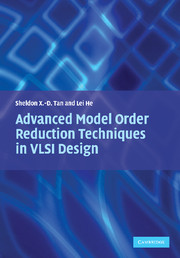Book contents
- Frontmatter
- Contents
- Figures
- Tables
- Foreword
- Acknowledgments
- 1 Introduction
- 2 Projection-based model order reduction algorithms
- 3 Truncated balanced realization methods for MOR
- 4 Passive balanced truncation of linear systems in descriptor form
- 5 Passive hierarchical model order reduction
- 6 Terminal reduction of linear dynamic circuits
- 7 Vector-potential equivalent circuit for inductance modeling
- 8 Structure-preserving model order reduction
- 9 Block structure-preserving reduction for RLCK circuits
- 10 Model optimization and passivity enforcement
- 11 General multi-port circuit realization
- 12 Reduction for multi-terminal interconnect circuits
- 13 Passive modeling by signal waveform shaping
- References
- Index
6 - Terminal reduction of linear dynamic circuits
Published online by Cambridge University Press: 19 January 2010
- Frontmatter
- Contents
- Figures
- Tables
- Foreword
- Acknowledgments
- 1 Introduction
- 2 Projection-based model order reduction algorithms
- 3 Truncated balanced realization methods for MOR
- 4 Passive balanced truncation of linear systems in descriptor form
- 5 Passive hierarchical model order reduction
- 6 Terminal reduction of linear dynamic circuits
- 7 Vector-potential equivalent circuit for inductance modeling
- 8 Structure-preserving model order reduction
- 9 Block structure-preserving reduction for RLCK circuits
- 10 Model optimization and passivity enforcement
- 11 General multi-port circuit realization
- 12 Reduction for multi-terminal interconnect circuits
- 13 Passive modeling by signal waveform shaping
- References
- Index
Summary
Complexity reduction and compact modeling of interconnect networks have been an intensive research area in the past decade, owing to increasing signal integrity effects and rising electro and magnetic couplings modeled by parasitic capacitors and inductors. Most previous research works mainly focus on the reduction of internal circuitry by various reduction techniques. The most popular one is based on subspace projection [32, 37, 85, 91, 113]. The projection-based method was pioneered by asymptotic waveform evaluation (AWE) algorithm [91], where explicit moment matching was used to compute dominant poles at low frequency. Later on, more numerical stable techniques were proposed [32,37,85,113] by using implicit moment matching and congruence transformation.
However, nearly all existing model order reduction techniques are restricted to suppress the internal nodes of a circuit. Terminal reduction, however, is less investigated for compact modeling of interconnect circuits. Terminal reduction is to reduce the number of terminals of a given circuit under the assumption that some terminals are similar in terms of performance metrics like timing or delays. Such reduction will lead to some accuracy loss. But terminal reduction can lead to more compact models after traditional model order reduction has been applied to the terminal-reduced circuit, as shown in Figure 6.1.
For instance, if we use subspace projection methods like PRIMA [85] for the model order reduction, a smaller terminal count will lead to smaller reduced models, given the same order of block moment requirement for both circuits.
- Type
- Chapter
- Information
- Advanced Model Order Reduction Techniques in VLSI Design , pp. 93 - 117Publisher: Cambridge University PressPrint publication year: 2007



